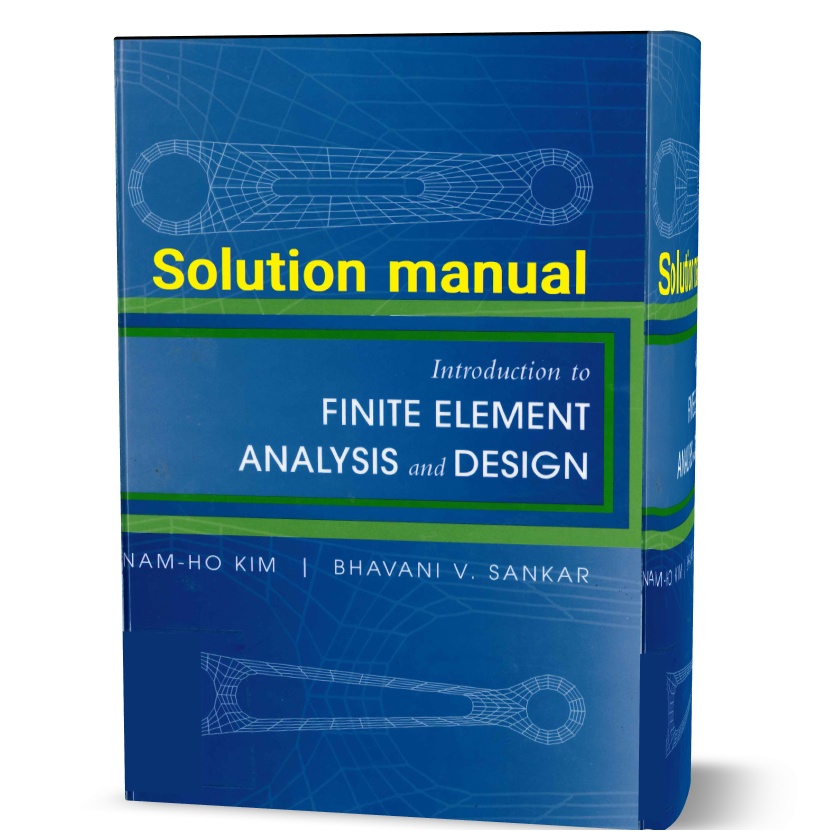دانلود حل المسائل کتاب مقدمه ای بر تحلیل و طراحی اجزای محدود ویرایش اول به نویسندگی نام هو کیم
solution manual for introduction to finite element analysis and design
نویسندگان: Nam-Ho Kim & Bhavani V. Sankar
تحلیل و طراحی اجزای محدود (Finite Element Analysis and Design) یک روش عددی است که برای تحلیل و بررسی رفتار و عملکرد سازهها، قطعات و سیستمهای فیزیکی مورد استفاده قرار میگیرد. این روش اصولاً بر پایه تقسیم سازه به بخشهای کوچکتر به نام عناصر محدود استوار است.
مقدمهای بر تحلیل و طراحی اجزای محدود شامل مراحل زیر میباشد: ebookband
1. مدلسازی: در این مرحله، سازه یا قطعه مورد نظر با استفاده از عناصر محدود تقسیم میشود. هر عنصر محدود دارای خواص مکانیکی است که برای مدلسازی مناسب آن قطعه استفاده میشود. مثالهایی از اجزا محدود عبارتند از خطوط، سطوح، مثلثها، مستطیلها و مکعبها.
2. تعیین شرایط مرزی: در این مرحله، شرایط مرزی بر روی عناصر محدود و ساختار به طور کامل تعیین میشوند. این شرایط ممکن است شامل بارگذاری خارجی، شرایط حاکم بر دیوارهها یا مرزهای سازه و شرایط مرزی مربوط به اتصالات باشد.
3. تعیین ویژگیهای مواد: خواص مکانیکی مواد استفاده شده در سازه، نیز باید به طور جداگانه مشخص شوند. این ویژگیها میتوانند شامل مقادیری مانند مدول کششی، مدول الاستیسیته، پیوستگی و ضریب لغزش باشند.
4. حل معادلات: در این مرحله، سیستم معادلات دیفرانسیلی مرتبه دوم حاکم بر ساختار بر حسب متغیرهای محلی هر عنصر محدود حل میشود. این معادلات وابسته به نوع تحلیل (استاتیکی یا دینامیکی) و شرایط مرزی است.
5. تحلیل نتایج: پس از حل معادلات، مقادیر مورد نیاز مانند انجمنهای اصلی و جوابهای جزئی برای هر عنصر محدود به دست میآیند. با استفاده از این نتایج میتوان رفتار سازه را در برابر بارگذاریهای مختلف، زمان و خرابی تحلیل کرد. ebookband.ir
این حل المسائل ویرایش اول میباشد 397 صفحه دارد و دارای 3.69 مگابایت حجم میباشد در این حل المسائل پاسخ فصل ها نوشته شده است. برای مشاهده نمونه بر روی لینک زیر کلیک نمایید.
introduction to finite element analysis and design solution manual
download free introduction to finite element analysis and design frist edition Nam Ho Kim & Bhavani V. Sankar solution manual ( solutions ) pdf is a numerical method for solving differential equations that describe many engineering problems. One of the reasons for FEM’s popularity is that the method results in computer programs versatile in nature that can solve many practical problems with a small amount of training. Obviously, there is a danger in using computer programs without proper understanding of the theory behind them, and that is one of the reasons to have a thorough understanding of the theory behind FEM. for more solution manual click here.
solution manual for introduction to finite element analysis and design
Many universities teach FEM to students at the junior/senior level. One of the biggest challenges to the instructor is finding a download free introduction to finite element analysis and design frist edition Nam Ho Kim & Bhavani V. Sankar solution manual ( solutions ) pdf appropriate to the level of students. In the past, FEM was taught only to graduate students who would carry out research in that field. Accordingly, many textbooks focus on theoretical development and numerical implementation of the method. However, the goal of an undergraduate FEM course is to introduce the basic concepts so that the students can use the method efficiently and interpret the results properly.
introduction to finite element analysis and design solution
Furthermore, the theoretical aspects of FEM must be presented without too many mathematical niceties. Practical applications through several design projects can help students to understand the method clearly. This download free introduction to finite element analysis and design frist edition Nam Ho Kim & Bhavani V. Sankar solution manual ( solutions ) pdf is suitable for junior/senior level undergraduate students and beginning graduate students in mechanical, civil, aerospace, biomedical and industrial engineering, and engineering mechanics; researchers and design engineers in the above fields.
دانلود نمونه رایگان حل المسائل
مشخصات حل المسائل ویرایش اول:
- ویرایش: 1st
- فرمت فایل: pdf
- حجم: 3.69MB
- تعداد صفحه: 397

